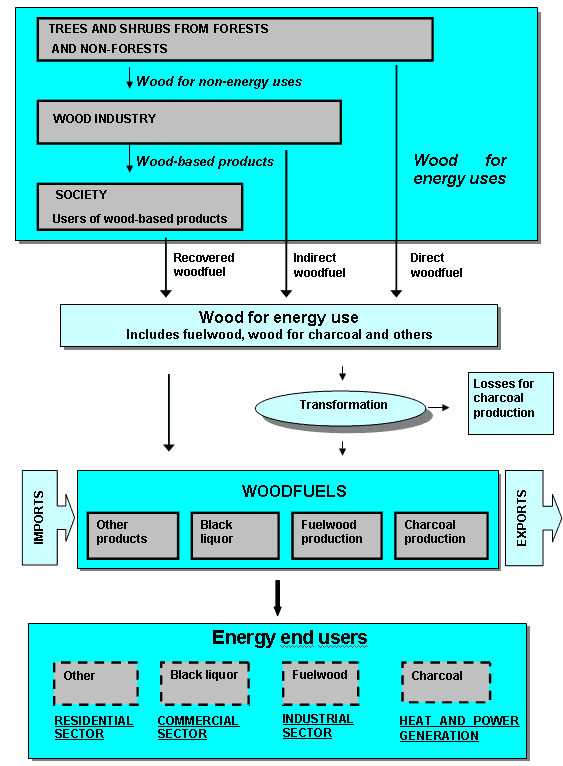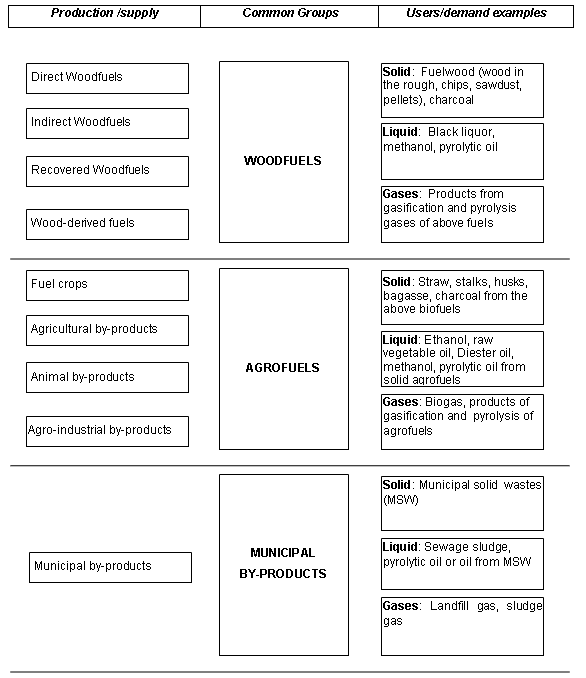


The basic idea behind the Uniform Wood Energy Terminology (UWET) is to create a suitable framework for the identification of the amount and type of wood energy flowing from different supply sources to meet end user needs. Thus, the fuel or product used to transport energy is the basic parameter to be accounted and properly classified. Both in commercial and non-commercial forms, these fuels should always be considered as effective commodities capable of meeting demand.
Figure 1 presents a conceptual view of physical wood energy flows to satisfy demand. The figure introduces the three different supply sources: nature (forests and trees outside forests), wood industries and society. The user’s side is also presented with an indication of the main sectors of demand. Additional considerations regarding wood energy trade complete the picture.
As a complement to the general picture given in Figure 1, a detailed biofuel classification system is presented in Table 1. The main consideration behind the classification suggested in Table 2 is the basic location of biomass production, in other words whether the biofuel was connected to forest, agricultural or municipal activity. The purpose of including a group on the use of agrofuels is to distinguish the classical biofuels (generally relating to forestry) from the more modern biofuels, which are basically oriented towards annual or multi-annual agricultural plantations.
The groups on the supply side are important sub-divisions that clearly identify the origin of the biofuels. On the end user side, the variety of fuels that can be produced for each group can be noted, thus allowing comparison and verification of data on both supply and demand. The far right column of Table 2 lists the different types of primary, secondary and even tertiary fuels that can be used for generating heat, electricity and power. Secondary and tertiary fuels often derive from raw biomass produced from a variety of sources after application of relatively complex transformation processes.
Bioenergy sources
Biofuels: these are organic primary and secondary fuels derived from biomass which can be used for the generation of thermal energy by combustion or some other technology. They comprise both purpose-grown energy crops and multipurpose plantations and by-products (residues and wastes). The term “by-products” includes the misnamed solid, liquid and gaseous residues and wastes derived from biomass processing activities. The main definitions employed in UWET include three types of biofuel: woodfuels, agrofuels, and municipal by-products.
Woodfuels
This category includes all types of biofuel derived directly and indirectly from trees and shrubs grown on forest and non-forest land. The definition of forest used in the FAO Forest Resources Assessment 1990 (FAO Forestry paper 124, p7) is very broad and includes lands with minimum crown cover of 20 percent in the developed countries and 10 percent in the developing countries. Woodfuels also include biomass derived from silvicultural activities (thinning, pruning etc.) and harvesting and logging (tops, roots, branches, etc.), as well as industrial by-products derived from primary and secondary forest industries which are used as fuel. They include woodfuels derived from ad hoc energy plantations.
Figure 1. Woodfuel balance from source to end-user

Table 1: Biofuel classification

Woodfuels can divided into three groups, according to their origin: Direct woodfuels, indirect woodfuels, and recovered woodfuels, as presented in Figure 1 and defined as follows. See also Table 2.
• Direct woodfuels: wood directly removed from forests (natural forests and plantations (land with crown cover over more than 10 percent of an area of more than 0.5 ha); Other woodlands (land with crown cover over 5-10 percent of area, with trees able to reach a height of at least 5 m at maturity in situ; or crown cover of more than 10 percent of area, with trees not reaching a height of 5 m at maturity in situ, and shrub or bush cover); and other lands able to supply energy demands, including both inventoried (recorded in official statistics) and non-inventoried woodfuels. Direct woodfuels can be directly burned or converted into another fuel, such as charcoal, pyrolysis gases, pellets, ethanol, methanol, etc.
• Indirect woodfuels: these are usually industrial by-products derived from the primary wood industry (sawmills, particle board plants, pulp and paper mills) and the secondary industry (joinery, carpentry), such as sawmill scrap, slabs, edgings and trimmings, sawdust, shavings and chips, black liquor, etc.. Indirect woodfuels can be burned directly or converted into another fuel, such as charcoal, pyrolysis gases, pellets, ethanol, methanol, etc.
• Recovered woodfuels: refers to woody biomass derived from all economic and social activities outside the forest sector, usually waste from construction sites, demolition of buildings, pallets, containers and boxes, etc., burned as they are or transformed into chips, pellets, briquettes, powder, etc.
As regards the products to be considered in wood energy accounts, woodfuels can be divided into four types: fuelwood, charcoal, black liquor and other, defined as follows.
• Fuelwood (or firewood): includes “wood in the rough” in small pieces (fuelwood), chips, pellets and powder derived from forests and isolated trees, as well as wood by-products from the timber industry and recovered wood products. They conserve the original basic structure of the wood and can be used either directly or after conversion into another woodfuel, such as charcoal. When needed, fuelwood can be converted into more convenient products, such as chips and pellets, without major chemical-physical processing.
Chips: wood in the rough that has been deliberately reduced to small pieces, or residues suitable for energy purposes.
Wood pellets: can be considered a fuel derived from the self-compaction of woody material from the combined application of heat and high pressure in an extrusion machine.
• Charcoal: refers to a solid residue derived from the carbonization, distillation, pyrolysis and torrefaction of wood (trunks and branches of trees) and wood by-products, using continuous or batch systems (pit, brick and metal kilns). It also includes charcoal briquettes.
Charcoal briquettes: made from wood-based charcoal which, after crushing and drying, is moulded (often under high pressure), generally with the admixture of binders to form artefacts of even shape.
• Black liquor: is the alkaline-spent liquor obtained from the digesters used in the production of sulphate or soda pulp during the process of paper production, in which the energy content is mainly derived from the content of lignin removed from the wood in the pulping process.
• Other woodfuels: includes a broad range of liquid and gaseous fuels derived from fuelwood and charcoal basically by pyrolytic or enzymatic processes, such as pyrolysis gases, ethanol, methanol, products of growing interest but to date not as important as energy commodities.
Table 2. Types of woodfuel supply source
Supply source | |||
Type of woodfuel |
Direct |
Indirect |
Recovered |
Fuelwood |
X |
X |
X |
Charcoal |
X |
X |
X |
Black liquor |
X |
||
Other (methanol, ethanol, pyrolytic gases) |
X |
X |
X |